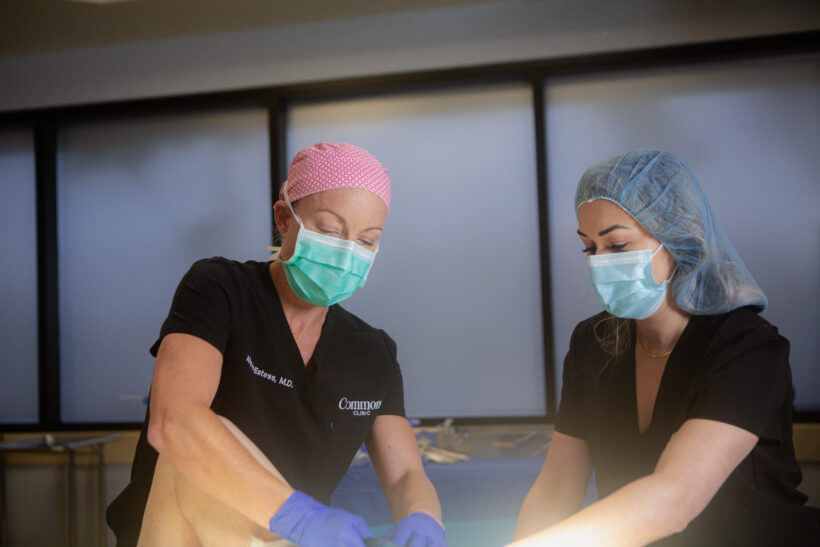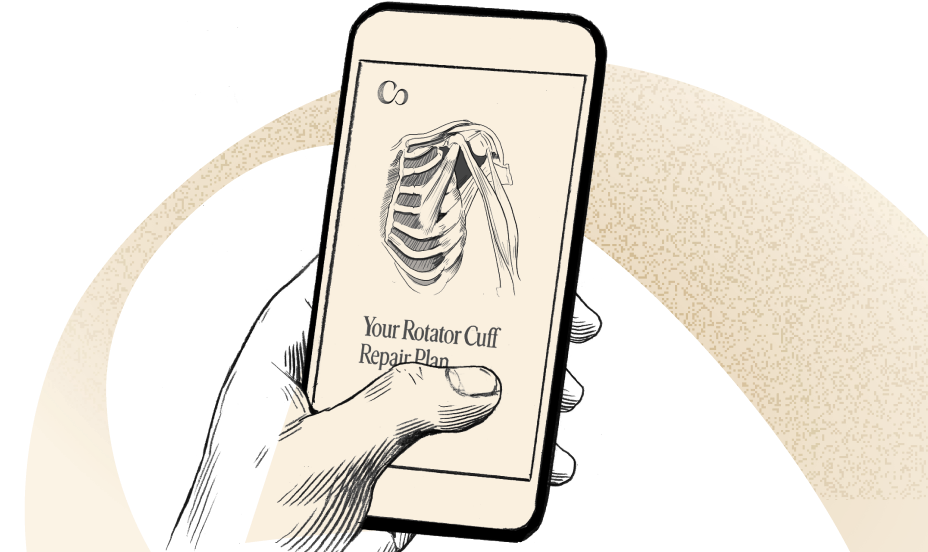Total Joint Replacement Surgery 101
Your complete guide to total joint replacement surgery: preparing for surgery, recovery, and getting back to the life you want.
You struggle to climb up or down stairs. When you wake up in the morning, your knees are so stiff, it’s tough to make it to the bathroom. You have difficulty putting on shoes or socks or it feels like you have a pulled groin muscle that never goes away. And you’re pretty sure that people can hear you—or the cracking noise coming from your knee—before you even enter a room. Any of these sound familiar? If so, you may have damage to joints that requires treatment.
Many times, treatment involves lifestyle changes or nonsurgical interventions. In other cases, an orthopedic surgeon will recommend a total joint replacement procedure to eliminate pain and improve mobility and function so you can go back and live the life you want again—whether that’s getting down on the floor to play with grandkids, walking the neighborhood with a friend, or playing in a community paddleball league.
Here’s what you need to know about when joint replacement surgery is needed, what the procedure entails, recovery, expectations, and more.
What Is Total Joint Replacement Surgery?
Total joint replacement surgery is a major surgery where the damaged joint is removed and replaced with artificial parts. A joint is a place in the body where two bones come together. According to the American Academy of Orthopaedic Surgeons (AAOS), a total joint replacement procedure can be done on several joints in the body, including the:
The hip and knee are the most common places where total joint replacement surgery is performed, says the AAOS. More than 1.3 million total knee and hip replacements are done every year in the U.S., according to data from the American College of Rheumatology.
Why Consider Joint Replacement Surgery?
Joints (such as the hip and knee) are lined with cartilage that helps the bones smoothly slide past one another during movement. The wear and tear of aging and conditions like osteoarthritis or rheumatoid arthritis can cause damage to “cartilage” or “the joints” that lead to pain and stiffness. Osteoarthritis joint replacement has become increasingly common as our population ages. Research shows that osteoarthritis is the most common reason for joint replacement surgery of the knee.
While there are lifestyle changes plus noninvasive or minimally invasive treatments for joint pain and stiffness—including exercise, anti-inflammatory medication, and steroid or hyaluronic acid injections—there comes a time when these remedies may not be enough, says Cory Calendine, M.D., a board-certified orthopaedic surgeon at the Bone and Joint Institute in Franklin, Tennessee.
“Joint replacement surgery is best for when all of the cartilage in the joint is gone, and the joint is moving bone-on-bone,” he says. “Once that happens, there is no effective way to rebuild the cartilage and we need to make the joint mechanical with artificial parts.”
This is not a decision to be made lightly. An orthopaedic surgeon typically uses the surgical repair of a joint as a final option. They can make this recommendation with a physical exam and talking to you about your symptoms and how they’re affecting your life. X-rays are taken to look for the amount of arthritis and damage to the joint. They help support the decision for surgery. However, if imaging shows bone-on-bone changes but you are still functioning well, it may not be time for surgery.
The most important factor in this surgical decision is how you’re feeling and functioning.

Preparing for Total Joint Replacement Surgery
If you’re scheduled for a total joint replacement surgery, here’s how you can prepare physically, mentally, and within your home for the procedure:
Get pre-surgical evaluation and tests
Your surgeon will want to ensure you’re healthy enough for the procedure and identify any potential risks. For your preop appointment, your surgeon may recommend:
- Imaging tests to assess joint damage and help with surgical planning, such as X-rays or a CT scan
- Blood tests, an EKG, and a physical exam to assess your health and ensure that it’s safe to proceed with surgery
- Staph testing (a bacteria naturally present on some people’s skin and in their nose). If you do have Staph, steps can be taken to reduce the risk of postop infection
Follow a healthy lifestyle
Good recovery and a safe surgery starts way before you even head into the operating room. Stay active with regular physical activity, consider physical therapy to help you prep your body for surgery, eat a balanced and nutritious diet, quit smoking, and decrease alcohol intake.
Identify a post-op partner
You’ll need support following joint replacement surgery. Talk to a loved one about helping transport you to and from the hospital for surgery. They may need to stay with you in your home for the first week during the immediate recovery period to help you safely move around, perform activities of daily living, and take you to follow-up appointments as needed.
Plan for discharge
Joint replacement surgery is a major surgery. Fortunately, “massive innovations in joint replacement, including pain management, has improved recovery,” says Dr. Calendine. Talk to your orthopaedic surgeon about what you can expect in terms of length of hospital stay, so you can properly prepare for the procedure.
“We used to keep patients in the hospital for a week, but now most people go home the same day and sleep in their bed on the first night,” he says. (Of course, there are medical reasons why you might be kept overnight at the hospital following surgery, so this may change depending on individual circumstances.) It’s important to understand the hospital stay recommended for you so you can arrange the support you need at home.
Set up your home
Are your stairs OK to navigate? Will you be able to bathe or shower or do you need to add assistive devices like a shower chair or grab bars? Can you get in and out of your bed OK? What can you remove from your floor or walkways that could otherwise be a trip hazard?
Now is the time to ask a loved one to help you arrange your home so that you can get around safely.
Ask for specific recommendations for your prep
Your medical team will provide detailed instructions specific to your case and procedure type. These guidelines are crucial for ensuring a safe and successful surgery. Talk to your surgeon about:
- What medications are and aren’t safe to take before surgery. This includes over-the-counter and prescription medications and supplements. Your medical team will let you know any adjustments you should make to your medications prior to surgery
- What you need to do to reduce infection. You may be advised to use a nasal swab and/or prescription skin washing and avoid shaving prior to surgery
- When to stop eating and drinking prior to surgery
- If you should start taking pain medications prior to surgery. This may be advised to reduce postsurgery pain

The Joint Replacement Surgery Process
You will have joint replacement surgery done in a hospital or outpatient surgery center. Regional or general anesthesia will be given. (Regional anesthesia numbs a large part of the body so you can’t feel pain. General anesthesia makes you fall asleep.)
In terms of the time needed, it takes up to a few hours to clean up the joint and place the prosthetic parts, though it can take as little as one hour. Your surgeon will:
- Make the necessary incision in the area of the joint. Depending on the joint replacement, your surgeon may use a minimally invasive technique that allows for smaller incisions compared to traditional surgery
- Remove damaged cartilage or bone and resurface the bone
- Replace it with implants made of metal, plastic, or ceramic materials. These prosthetics come in different shapes and sizes. Your surgeon will choose the parts that best fit your body
- Insert other parts, such as a spacer, to help the joint glide well
- Provide pain medication injection into the joint to improve postop pain and close up the incision
Total joint replacement surgery is increasingly performed using robotic-assisted surgery. “We use a robotic arm to make precise cuts in the prosthesis needed to match the anatomy,” says Dr. Calendine. In general, this type of procedure enhances accuracy, reduces alignment issues, and may result in improved short-term results compared to conventional joint surgeries that uses manual instruments, notes research in the journal Bone & Joint Open.
However, both robotic and conventional surgery can lead to successful outcomes. Ask your surgeon to walk you through what you can expect from your surgery, including what the procedure entails, and make sure you are comfortable with the procedure ahead.
Recovery and Rehabilitation After Joint Replacement Surgery
First, stay on top of pain management. Managing pain with pain medications is important immediately after surgery. Talk to your health care team about when to take pain medication, how much, and what to do if pain persists.
Not only are more joint replacement surgeries done on an outpatient basis, allowing you to go home the same day, but recovery looks a lot different than it used to, says Dr. Calendine. That’s because of the benefits to an active recovery.
Gone are the days where you stay in a hospital on bed rest. Now, you’re encouraged to get up and move around as early as possible. Doing so improves blood flow to the surgical area, reduces stiffness, and can lessen the need for pain medication. Talk to your surgeon about their specific recommendations about when you should return to movement.
You’ll also use assistive devices to aid in safe activity. “For hip or knee replacements, we’ll start patients on a walker for a few days for balance. When their balance comes back, we switch to a cane,” says Dr. Calendine.
Physical therapy (PT) is also paramount to proper recovery, as it helps you regain motion, flexibility, and function in the joint. Depending on the joint replacement, your orthopaedic specialist may have different recommendations. PT is crucial for helping the knee return to mobility. You may work with a physical therapist in person three times a week for six weeks. For hip replacement, you may be able to do exercises at home on your own.
Finally, watch for possible surgery complications and report them to your doctor. According to the National Institute of Arthritis and Musculoskeletal and Skin Diseases, complications for total joint surgery can include:
- Blood clots
- Infection
- Issues with wound healing
- Dislocation (with hips)
- While less common, blood vessel injury and nerve injury are also complications.
Although the risks of surgery and rates of complications will differ depending on the type of joint replacement you’re having, many patients experience temporary symptoms. Serious complications are rare, occurring in less than 1 to 3% of cases. The vast majority of these were minor, such as joint stiffness, joint swelling, and “pins and needles” sensations.
Benefits and Long-Term Outcomes of Joint Replacement Surgery
Although surgery is used as a final option, it can make a huge difference in your quality of life. “One of the most common things I hear is ‘why didn’t I do this earlier?'” says Dr. Calendine. According to a small, 2023 study of patients published in the journal Arthroplasty Today, 100% and 94% of patients receiving total hip or total knee replacement said they would have the procedure done again, suggesting they were satisfied with the surgery and results.
Within four to six weeks, you can expect to be back to most day-to-day activities. It may take three to six months to return to full activity, and one year (or beyond) to be considered completely healed.
“The joint will improve for a year or two as the muscles around the joint continue to strengthen,” he says. “While we take away osteoarthritis in a joint with a snap of a finger with surgery, the muscle recovery takes longer.”
As strength, mobility, and function in your joint return, you will have few activity restrictions. Certainly, you will want to enter into activities slowly and safely, but you will be physically capable to take on new challenges. “If you want to get back to walking, hiking, cycling, you can do anything you want to do. We’re doing joint replacement for your quality of life,” Dr. Calendine adds.
Alternatives to Joint Replacement Surgery
If you are not ready for joint replacement surgery or it is not recommended at this time, there are other things you can do to improve movement and pain in your joint.
You can take nonsteroidal anti-inflammatory medication (NSAIDs) and ask about corticosteroid injections, which are placed in the joint. Stay active with exercise, and look for an exercise program that caters to adults with arthritis. Consider signing up for physical therapy for individualized exercises, reduce your weight to lessen joint stress, and wear supportive devices like braces or orthotics.
When to Seek Professional Advice
It can be common to think that painful or stiff joints are a normal part of aging. Not so. There are numerous solutions for joint problems, including nonsurgical and surgical options. Still, an orthopaedic specialist can recommend a treatment plan that improves pain, mobility, and function that’s right for your needs. Consult an orthopaedic specialist if you experience the following signs:
- Persistent pain and swelling despite at-home treatments
- Symptoms that affect your ability to work or perform daily activities
- Limited joint stability and range of motion
Early intervention can lead to better outcomes and may help you avoid more invasive treatments later. Remember that you don’t have to live with joint pain, and seeking help is the first step toward improving your quality of life. Your orthopaedic specialist can help you navigate the best path forward for your specific situation.
Frequently Asked Questions (FAQs)
What is a joint replacement?
Total joint replacement is a surgical procedure where the damaged parts of the bone and cartilage in a joint are removed and replaced with prosthetic materials to relieve joint pain and improve function.
Is joint replacement a major surgery?
Yes, joint replacement is considered a major surgery. Depending on the joint being operated on, you will need either regional or general anesthesia. However, many times joint replacement can be done on an outpatient basis, meaning you will go home that day.
How long does a total joint replacement take?
Joint replacement is performed on a variety of joints, including the knee and hip. Time in surgery is based on the specific patient and the joint that is operated on. Generally, joint replacement takes a few hours to perform. However, some surgeries may take just one hour.
What are the hardest days after total knee replacement?
The time right after surgery is the hardest time after total knee replacement. You can expect pain after surgery, limitations on mobility, and weakness. However, you will slowly improve over time. Working closely with your care team on pain management, asking a loved one to help you move around immediately after surgery, and following recommended physical therapy will help you get on track to a full recovery.
What is the difference between TKA and TKR?
TKA stands for total knee arthroplasty (also known as total knee replacement surgery). TKR stands for total knee replacement. Both of these terms can be used for the same thing, though TKA is more of a medical term doctors will use.
Conclusion
Total joint replacement is a major surgery that removes damaged parts of a joint and replaces them with artificial parts. Overall, the success of a total joint replacement surgery depends on your symptoms, goals, and commitment to recovery. An orthopedic specialist may recommend this procedure for you if lifestyle changes like exercise and weight loss and other non-surgical treatments have not or no longer work for you.
If you experience joint pain or mobility problems that greatly impact your function, total joint replacement can help you get your life back. Still, it’s not a decision to take lightly. Connect with a physician at Commons Clinic. Our specialists can help guide you through the process and help you make informed decisions about your treatment.
Sources
StatPearls. Anatomy, Joints. April 21, 2024.
https://www.ncbi.nlm.nih.gov/books/NBK507893
American Academy of Orthopaedic Surgeons (AAOS). Total Joint Replacement. February 2021.
https://orthoinfo.aaos.org/en/treatment/total-joint-replacement
American College of Rheumatology. Joint Replacement Surgery. February 2024.
https://rheumatology.org/patients/joint-replacement-surgery
NorthShore University HealthSystem. Total Joint Replacement: Your Guide to Rapid Recovery.
University of Maryland Medical System. Joint Replacement Surgery Patient Education.
https://www.umms.org/health-services/orthopedics/joint-replacement/patient-ed
Keck Medicine. Joint Replacement: Pre-Operative Information for Joint Replacement Surgery. September 2021.
https://www.keckmedicine.org/wp-content/uploads/2021/09/Lieberman_handbook_post_surgery-web.pdf
National Institute of Arthritis and Musculoskeletal and Skin Diseases. Joint Replacement Surgery: Health Information Basics for You and Your Family. May 2023.
University of Maryland Medical System. Total Hip and Knee Replacement Procedures.
https://www.umms.org/health-services/orthopedics/joint-replacement/procedures
American Academy of Orthopaedic Surgeons (AAOS). Total Knee Replacement. February 2024.
https://orthoinfo.aaos.org/en/treatment/total-knee-replacement
Bone & Joint Open. Comparative assessment of current robotic-assisted systems in primary total knee arthroplasty. December 23, 2022.
https://pmc.ncbi.nlm.nih.gov/articles/PMC9887337
Orthopaedic Surgery. Enhanced Recovery after Total Joint Arthroplasty (TJA): A Contemporary Systematic Review of Clinical Outcomes and Usage of Key Elements. March 27, 2023.
https://pmc.ncbi.nlm.nih.gov/articles/PMC10157715
BMC Musculoskeletal Disorders. Complications to 6 months following total hip or knee arthroplasty: observations from an Australian clinical outcomes registry. September 10, 2020.
https://pmc.ncbi.nlm.nih.gov/articles/PMC7488141
Arthroplasty Today. Assessment of Patient Satisfaction and Outcomes After Outpatient Joint Arthroplasty in Academic Medical Centers. November 10, 2023.







 (310) 574-0367
(310) 574-0367